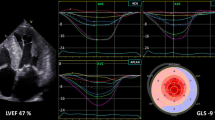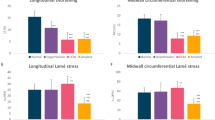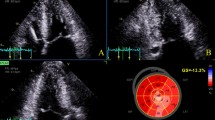Abstract
Left ventricular ejection fraction (LVEF) has a limited role in predicting outlook in heart diseases including heart failure. We quantified the independent geometric factors that determine LVEF using cardiac MRI and sought to provide an improved measure of ventricular function by adjusting for such independent variables. A mathematical model was used to analyse the independent effects of structural variables and myocardial shortening on LVEF. These results informed analysis of cardiac MRI data from 183 patients (53 idiopathic dilated cardiomyopathy (DCM), 36 amyloidosis, 55 hypertensives and 39 healthy controls). Left ventricular volumes, LVEF, wall thickness, internal dimensions and longitudinal and midwall fractional shortening were measured. The modelling demonstrated LVEF increased in a curvilinear manner with increasing mFS and longitudinal shortening and wall thickness but decreased with increasing internal diameter. Controls in the clinical cohort had a mean LVEF 64 ± 7%, hypertensives 66 ± 8%, amyloid 49 ± 16% and DCM 30 ± 11%. The mean end-diastolic wall thickness in controls was 8 ± 1 mm, DCM 8 ± 1 mm, hypertensives 11 ± 3 mm and amyloid 14 ± 3 mm, P < 0.0001). LVEF correlated with absolute wall thickening relative to ventricular size (R2 = 0.766). A regression equation was derived from raw MRI data (R2 = 0.856) and used to ‘correct’ LVEF (EFc) by adjusting the wall thickness and ventricular size to the mean of the control group. Improved quantification of the effects of geometric changes and strain significantly enhances understanding the myocardial mechanics. The EFc resulted in reclassification of a ‘ventricular function’ in some individuals and may provide an improved measure of myocardial performance especially in thick-walled, low-volume ventricles.





Similar content being viewed by others
Data availability
Available for senior author upon reasonable request.
Code availability
N/A. Equations provided in Appendix.
Abbreviations
- AWT:
-
Absolute wall thickening
- DCM:
-
Dilated cardiomyopathy
- EDWT:
-
End-diastolic wall thickness
- EDV:
-
End-diastolic volume
- ESWT:
-
End-systolic wall thickness
- HFmrEF:
-
Heart failure with mid-range ejection fraction
- HFpEF:
-
Heart failure with preserved ejection fraction
- HFrEF:
-
Heart failure with reduced ejection fraction
- HHD:
-
Hypertensive heart disease
- HTN:
-
Hypertension
- LAS:
-
Long-axis shortening
- LVEF:
-
Left ventricular ejection fraction
- LVIDd:
-
Left ventricular internal diameter at end-diastole diameter
- LVIDs:
-
Left ventricular internal diameter at end-systole
- mFS:
-
Midwall fractional shortening
- rAWT:
-
Relative absolute wall thickening
- RS:
-
Radial strain
References
Volpi A, De Vita C, Franzosi MG, Geraci E, Maggioni AP, Mauri F et al (1993) Determinants of 6-month mortality in survivors of myocardial infarction after thrombolysis. Results of the GISSI-2 data base. The Ad hoc Working Group of the Gruppo Italiano per lo Studio della Sopravvivenza nell’Infarto Miocardico (GISSI)-2 Data Base. Circulation 88(2):416–429. https://doi.org/10.1161/01.cir.88.2.416
Lam CS, Donal E, Kraigher-Krainer E, Vasan RS (2011) Epidemiology and clinical course of heart failure with preserved ejection fraction. Eur J Heart Fail 13(1):18–28. https://doi.org/10.1093/eurjhf/hfq121
Bhatia RS, Tu JV, Lee DS, Austin PC, Fang J, Haouzi A et al (2006) Outcome of heart failure with preserved ejection fraction in a population-based study. N Engl J Med 355(3):260–269. https://doi.org/10.1056/NEJMoa051530
Owan TE, Hodge DO, Herges RM, Jacobsen SJ, Roger VL, Redfield MM (2006) Trends in prevalence and outcome of heart failure with preserved ejection fraction. N Engl J Med 355(3):251–259. https://doi.org/10.1056/NEJMoa052256
Ponikowski P, Voors AA, Anker SD, Bueno H, Cleland JG, Coats AJ et al (2016) ESC guidelines for the diagnosis and treatment of acute and chronic heart failure: The task force for the diagnosis and treatment of acute and chronic heart failure of the European society of cardiology (ESC). Developed with the special contribution of the Heart failure association (HFA) of the ESC. Eur J Heart Fail 18(8):891–975. https://doi.org/10.1002/ejhf.592
Paulus WJ, Tschope C, Sanderson JE, Rusconi C, Flachskampf FA, Rademakers F et al (2007) How to diagnose diastolic heart failure: a consensus statement on the diagnosis of heart failure with normal left ventricular ejection fraction by the heart failure and echocardiography associations of the european society of cardiology. Eur Heart J 28:2539–2550
Kraigher-Krainer E, Shah AM, Gupta DK, Santos A, Claggett B, Pieske B et al (2014) Impaired systolic function by strain imaging in heart failure with preserved ejection fraction. J Am Coll Cardiol 63(5):447–456. https://doi.org/10.1016/j.jacc.2013.09.052
Aurigemma GP, Gaasch WH, McLaughlin M, McGinn R, Sweeney A, Meyer TE (1995) Reduced left ventricular systolic pump performance and depressed myocardial contractile function in patients > 65 years of age with normal ejection fraction and a high relative wall thickness. Am J Cardiol 76(10):702–705. https://doi.org/10.1016/s0002-9149(99)80201-x
Vinch CS, Aurigemma GP, Simon HU, Hill JC, Tighe DA, Meyer TE (2005) Analysis of left ventricular systolic function using midwall mechanics in patients > 60 years of age with hypertensive heart disease and heart failure. Am J Cardiol 96(9):1299–1303
Koh YS, Jung HO, Park MW, Baek JY, Yoon SG, Kim PJ et al (2009) Comparison of left ventricular hypertrophy, fibrosis and dysfunction according to various disease mechanisms such as hypertension, diabetes mellitus and chronic renal failure. J Cardiovasc Ultrasound 17(4):127–134
Levy D, Garrison RJ, Savage DD, Kannel WB, Castelli WP (1990) Prognostic implications of echocardiographically determined left ventricular mass in the framingham heart study. N Engl J Med 322(22):1561–1566. https://doi.org/10.1056/NEJM199005313222203
Koren MJ, Devereux RB, Casale PN, Savage DD, Laragh JH (1991) Relation of left ventricular mass and geometry to morbidity and mortality in uncomplicated essential hypertension. Ann Intern Med 114(5):345–352. https://doi.org/10.7326/0003-4819-114-5-345
Maciver DH, Townsend M (2008) A novel mechanism of heart failure with normal ejection fraction. Heart 94(4):446–449. https://doi.org/10.1136/hrt.2006.114082
Maciver DH (2011) A new method for quantification of left ventricular systolic function using a corrected ejection fraction. Eur J Echocardiogr 12(3):228–234. https://doi.org/10.1093/ejechocard/jeq185
Stokke TM, Hasselberg NE, Smedsrud MK, Sarvari SI, Haugaa KH, Smiseth OA et al (2017) Geometry as a confounder when assessing ventricular systolic function: comparison between ejection fraction and strain. J Am Coll Cardiol 70(8):942–954. https://doi.org/10.1016/j.jacc.2017.06.046
Pennell DJ (2002) Ventricular volume and mass by CMR. J Cardiovasc Magn Reson 4(4):507–513. https://doi.org/10.1081/jcmr-120016389
MacIver DH, Adeniran I, Zhang H (2015) Left ventricular ejection fraction is determined by both global myocardial strain and wall thickness. Int J Cardiol Heart Vasc 7:113–118. https://doi.org/10.1016/j.ijcha.2015.03.007
Yin FC, Chan CC, Judd RM (1996) Compressibility of perfused passive myocardium. Am J Physiol 271(5 Pt 2):H1864–H1870. https://doi.org/10.1152/ajpheart.1996.271.5.H1864
Maciver DH (2012) The relative impact of circumferential and longitudinal shortening on left ventricular ejection fraction and stroke volume. Exp Clin Cardiol 17(1):5–11
Rodrigues JC, Rohan S, Dastidar AG, Trickey A, Szantho G, Ratcliffe LE et al (2016) The relationship between left ventricular wall thickness, myocardial shortening, and ejection fraction in hypertensive heart disease: insights from cardiac magnetic resonance imaging. J Clin Hypertens 18(11):1119–1127. https://doi.org/10.1111/jch.12849
Maceira AM, Joshi J, Prasad SK, Moon JC, Perugini E, Harding I et al (2005) Cardiovascular magnetic resonance in cardiac amyloidosis. Circulation 111(2):186–193. https://doi.org/10.1161/01.CIR.0000152819.97857.9D
Pozo E, Kanwar A, Deochand R, Castellano JM, Naib T, Pazos-Lopez P et al (2014) Cardiac magnetic resonance evaluation of left ventricular remodelling distribution in cardiac amyloidosis. Heart 100(21):1688–1695. https://doi.org/10.1136/heartjnl-2014-305710
Maceira AM, Prasad SK, Khan M, Pennell DJ (2006) Normalized left ventricular systolic and diastolic function by steady state free precession cardiovascular magnetic resonance. J Cardiovasc Magn Reson 8(3):417–426. https://doi.org/10.1080/10976640600572889
Kawel N, Turkbey EB, Carr JJ, Eng J, Gomes AS, Hundley WG et al (2012) Normal left ventricular myocardial thickness for middle-aged and older subjects with steady-state free precession cardiac magnetic resonance: the multi-ethnic study of atherosclerosis. Circ Cardiovasc Imaging 5(4):500–508. https://doi.org/10.1161/CIRCIMAGING.112.973560
MacIver DH, Stephenson RS, Jensen B, Agger P, Sanchez-Quintana D, Jarvis JC et al (2018) The end of the unique myocardial band: Part I. Anatomical considerations. Eur J Cardiothorac Surg 53(1):112–119. https://doi.org/10.1093/ejcts/ezx290
de Simone G, Devereux RB, Roman MJ, Ganau A, Saba PS, Alderman MH et al (1994) Assessment of left ventricular function by the midwall fractional shortening/end-systolic stress relation in human hypertension. J Am Coll Cardiol 23(6):1444–1451. https://doi.org/10.1016/0735-1097(94)90390-5
de Simone G, Devereux RB (2002) Rationale of echocardiographic assessment of left ventricular wall stress and midwall mechanics in hypertensive heart disease. Eur J Echocardiogr 3(3):192–198. https://doi.org/10.1053/euje.2002.0163
Laskey WK, Alomari I, Cox M, Schulte PJ, Zhao X, Hernandez AF et al (2015) Heart rate at hospital discharge in patients with heart failure is associated with mortality and rehospitalization. J Am Heart Association 4(4):e001626
Lam PH, Dooley DJ, Deedwania P, Singh SN, Bhatt DL, Morgan CJ et al (2017) Heart rate and outcomes in hospitalized patients with heart failure with preserved ejection fraction. J Am Coll Cardiol 70(15):1861–1871. https://doi.org/10.1016/j.jacc.2017.08.022
MacIver DH, Dayer MJ, Harrison AJ (2013) A general theory of acute and chronic heart failure. Int J Cardiol 165(1):25–34. https://doi.org/10.1016/j.ijcard.2012.03.093
Forsythe L, MacIver DH, Johnson C, George K, Somauroo S, Papadakis M et al (2018) The relationship between left ventricular structure and function in the elite senior rugby football league athlete as determined by conventional 2D echocardiography and myocardial strain imaging. Int J Cardiol 261:211–217
MacIver DH (2014) The impact of mitral regurgitation on left ventricular ejection fraction using mathematical modelling. Exp Clin Cardiol 20(9):4994–5008
Rodrigues JC, Dastidar AG, Paton JF, MacIver DH (2016) Precursors of hypertensive heart phenotype develop in healthy adults: an alternative explanation. JACC Cardiovasc Imaging 9(6):762–763. https://doi.org/10.1016/j.jcmg.2015.11.016
Funding
Study was supported by Bristol NIHR Biomedical Research Centre.
Author information
Authors and Affiliations
Contributions
All authors take responsibility for all aspects of the reliability and freedom from bias of the data presented and their discussed interpretation. DHM was responsible for the conception and design of the work. JCLR, BR, KH and SR collected the clinical data. DHM undertook the mathematical modelling. JCLR wrote the first draft. All authors are responsible for the accuracy of the final document and act as guarantors. All authors gave substantial contributions to interpretation of data, manuscript revisions and for intellectual content. All authors approved the final version published. All authors agreed to be accountable for all aspects of the work in ensuring that questions related to the accuracy or integrity of any part of the work are appropriately investigated and resolved. The scientific guarantor of this publication is Prof David MacIver.
Corresponding author
Ethics declarations
Conflict of interest
JCLR reports speaker’s fees from Sanofi and consultancy fees from NHSX outside the scope of this work. All other authors have no conflicts to declare.
Ethical approval
The local research ethics committee confirmed that this study conformed to the governance arrangements for research ethics committees.
Consent to participate
All subjects provided informed, written consent.
Consent for publication
All authors consent for publication.
Additional information
Publisher's Note
Springer Nature remains neutral with regard to jurisdictional claims in published maps and institutional affiliations.
Appendix
Appendix
Midwall fractional shortening
Midwall fractional shortening was estimated using the following established [26]:
where:
Regression equations
Multiple linear regression (n = 183) of MRI cohort. D = left ventricular end-diastolic diameter (mm), W = end-diastolic wall thickness (mm), L = end-diastolic left ventricular length (mm), εL = long axis shortening (%), εC = midwall (circumferential) fractional shortening (%). Four statistical models were produced (Eqs. 1, 2, 3, 4). The highest correlation coefficient was obtained using all five input variables (Eq. 1) and the lowest with three variables including longitudinal shortening (Eq. 3):
5 degrees of freedom (D, W, εL, εC, L)
4 degrees of freedom (D, W, εL, εC)
3 degrees of freedom (D, W, εL)
3 degrees of freedom (D, W, εC)
Rights and permissions
About this article
Cite this article
Rodrigues, J.C.L., Rooms, B., Hyde, K. et al. The corrected left ventricular ejection fraction: a potential new measure of ventricular function. Int J Cardiovasc Imaging 37, 1987–1997 (2021). https://doi.org/10.1007/s10554-021-02193-4
Received:
Accepted:
Published:
Issue Date:
DOI: https://doi.org/10.1007/s10554-021-02193-4




